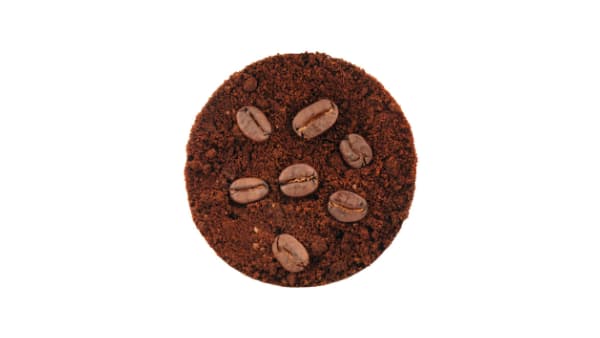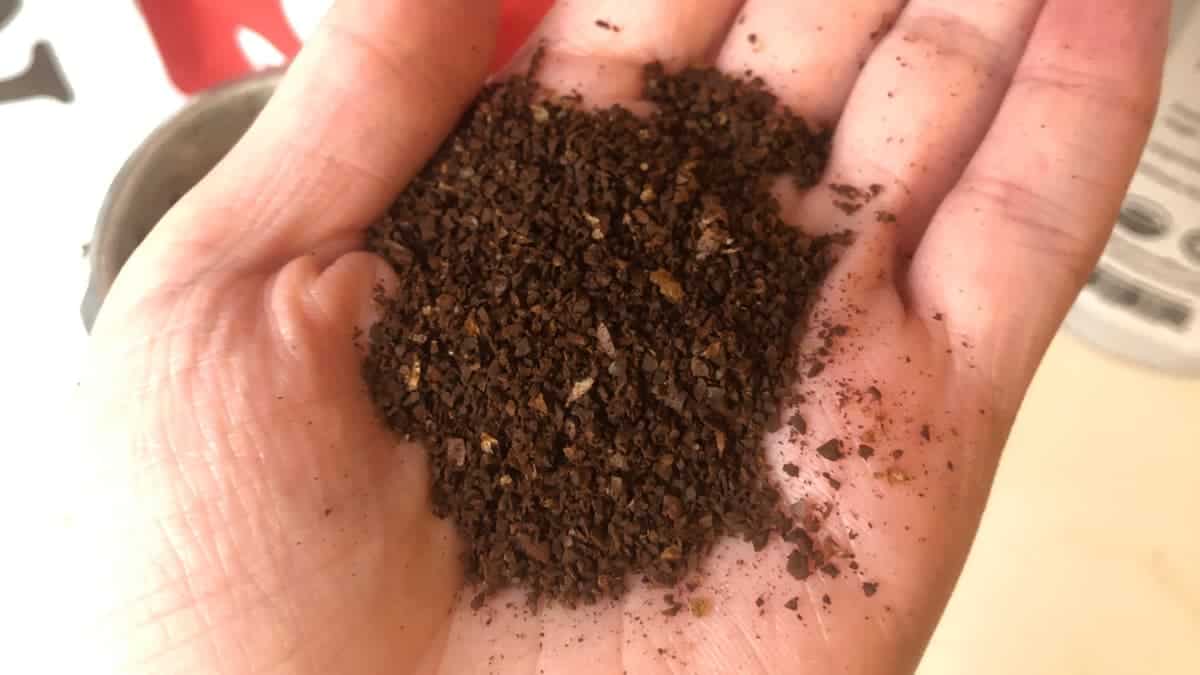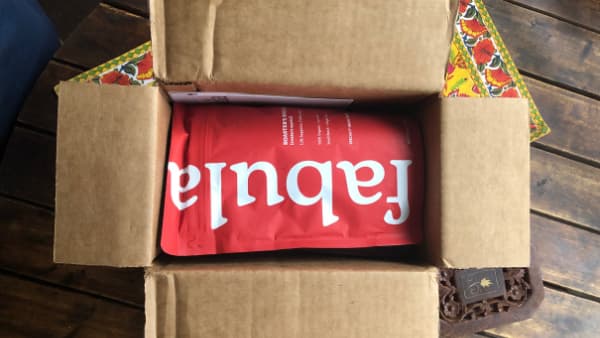Can You Grind Coffee Beans in a Blender?
After espresso machines, the thing I miss most about working in coffee shops is access to high quality coffee grinders.
So many adjustable grind settings, pre-set timers, generous bean hoppers…Grinding coffee at home isn’t so simple.
Maybe, like me, you’re saving up to buy a top-of-the-line conical burr grinder. Or maybe you’re reluctant to buy yet another kitchen appliance. Whatever the reason, if you don’t have access to a grinder, can you grind coffee beans in a blender?
Let’s find out.

Can You Grind Coffee In A Blender?
Yes. You can grind coffee in a blender. Unfortunately, I wouldn’t necessarily recommend it.
I love finding creative and cheap solutions. But I don’t think a blender is the best way to achieve freshly ground coffee.
That’s because it’s very difficult to control the grind size using a blender. So you won’t be able to get your exact desired consistency. This might not be an issue if you need coarse grinds. But if your grinds are too coarse for your brew method, you’ll end up with a weak, watery coffee.
The other issue with using a blender to grind beans? Consistency.
It’s nearly impossible to achieve uniformly sized particles. Think of what happens to frozen berries when they meet blender blades. Now imagine how much tiny coffee beans will bounce around. With all that bouncing, you’re not going to achieve even grind sizes.
Grinding Beans in a Blender Summary
Yes, you can use a blender to grind coffee. If you have no other option and you’re desperate for a morning brew, a blender will grind beans.
But when it comes to consistent grind size, a blender can’t replace a quality coffee grinder. You also won’t be able to achieve fine grinds using a blender.

Why a Burr Grinder Is Better than a Blade
Using a burr grinder is the best way to grind your coffee beans. It will give you both uniformly sized particles and greater control over grind size.
A burr grinder contains two nesting burrs. One burr remains stationary while the other burr rotates. Both burrs have abrasive surfaces.
The beans are crushed between these surfaces, resulting in more size consistency. Plus, you can easily control the size of the grounds by adjusting the space between the burrs.
The main downside is price. Burr grinders are more expensive than blade grinders. But flat or conical, they’re worth the extra cost.
A blade grinder uses rotating metal blades (think of a propeller) to chop beans. Although a blade grinder can achieve fine grinds, it produces less consistent grinds.
Blade grinders also generate heat as they grind. This heat transfers to the coffee grinds, in some cases causing a burnt taste.
Take a quick look at the bottom of your blender, and you’ll see that it’s more similar to a blade grinder than a burr grinder.
Grind Size, Flavor & Blenders
Before we dismiss blender beans completely, let’s get into the nitty gritty: grind size.
Grind size impacts coffee extraction. The finer the grind the shorter the extraction time. So you need to match the size of the grind with the appropriate brew method.
It’s difficult to evaluate grind size in the best of circumstances. Coarse grinds are just over 1mm per particle. Extra fine grinds measure at under 0.25 mm. So yeah, you can see that they’re small. But are they the right kind of small?
Electric burr grinders allow you to pre-select grind size. Blenders not so much.
Unfortunately, blenders give you no control over grind size and particle uniformity. This variability increases the likelihood of over or under-extracting the coffee.
Uneven grinds lead to uneven extraction. Coarse grinds need a longer extraction time than fine grinds. So a mix of both will lead to a bad cup of coffee.
Too long and you’ll over-extract the fine grinds, resulting in a bitter cup. Too short and you’ll under-extract the coarse grinds, leading to a sour cup. Either way you brew ‘em, uneven grinds harm the flavor of your coffee.
Fortunately, some brewing methods are better suited for handling less than ideal grinds. If you’re using a blender to grind coffee, choose a forgiving brew method.
It will be basically impossible to achieve a fine grind in a blender. So forget about using blender grounds for espresso, Moka pot, or AeroPress.
Instead, brew coffee in a cafetière.
How To Grind Coffee Beans in a Blender
The basic act of grinding coffee beans using a blender is pretty straightforward. But blenders don’t offer much in the way of precision and control. So perfecting technique takes a bit of patience.
Before you start grinding, check your blender’s user manual. The motor that works fine for smoothies might not manage hard beans.
Pour ¼ to ½ cup of roasted beans into the blender. Place the lid securely on the blender.
Switch the blender to the “grind” setting. If your blender doesn’t have a setting for grinding, select a medium-high setting.
Pulse the beans for three to five seconds at a time. Repeat this process until you’ve achieved your desired grind size.
Remember, the process of grinding heats the beans. And heat reduces flavor quality. So don’t pulse the beans for more than 30 seconds total.
If necessary, tilt the blender to aid grind consistency. This is where technique comes into play.
Pro tip: use cheap beans when you first begin your blender experiments.
Grinding Without A Grinder Alternatives
Don’t have a blender? You’re not out of luck just yet. Here are a few other ways to grind beans without a grinder.
Mortar and Pestle
Typically used to crush spices, a mortar and pestle can work in the absence of a burr or blade grinder. This stone age kitchen tool requires a bit of elbow grease, so it’s best suited for one cup of coffee rather than a huge batch.
Place a small scoop of beans in the mortar. Use the pestle to crush the beans. You won’t be able to produce a consistent grind size. But work until you achieve grinds around the size of kosher salt.
For best results, use a ceramic mortar rather than a wood or metal one. Brew the grounds as French press or cold brew.

Food Processor
If you want to avoid manual grinding, you can use food processors to grind beans. Simply pop the beans in the processor and pulse to grind.
This option maximizes convenience. But it won’t achieve fine or consistent grind sizes. Plus, the blades will heat up the beans and produce bitter flavors.
So if you do decide to grind your beans using a food processor, brew the grinds as French presses.
Rolling Pin
When you’re desperate for a DIY coffee grinder, a rolling pin can help you crush the beans by hand.
Place the beans in a Ziploc bag. Set this bag on a hard, flat surface. Use a rolling pin to crush the beans. Roll over the beans until you have the desired grind size. (Again, it will be very difficult to produce uniform grinds.)
If you’re short on baking supplies, you can use a sturdy glass or other cylindrical object to roll over the beans.
Pre-ground Coffee Might Be Better
Grinding coffee beans immediately before brewing is a crucial step toward making a delicious cup of coffee. The fresh grounds will be more aromatic and flavorful than pre-ground coffee.
Unground beans contain carbon dioxide, which helps prevent them from going stale. The grinding process releases this carbon dioxide and exposes more surface to oxygen.
Whole beans offer optimal freshness for two to three weeks after roasting. Pre-ground coffee has a much shorter shelf life, with peak flavors lasting just a few days after opening.
Stale coffee won’t make you sick. And no, pre-brewed coffee won’t start rotting once it passes its expiration date. Nevertheless, the longer coffee oxidizes, the more flavor it loses.
Fresh ground beans are always better than pre-ground beans. Simple, right? But coffee is where chemistry meets art. So let’s stay open to experimentation.
In some cases, using pre-ground coffee might be better than using a blender to grind your coffee. Hear me out.
Bean freshness is not the only factor that impacts coffee flavor. Grind size and consistency are also important.
When you grind a coffee bean, you increase the surface area available for extraction. So the finer the grind size, the faster the extraction.
Inconsistent grinds also cause trouble. Finer grinds will become over-extracted while coarser grinds will be under-extracted. Anyway you brew it, your coffee will either be too sour or too bitter.
So when should you buy pre-ground over whole unground beans?
First, consider your preferred brew method. Espresso, Moka pot, and Aeropres coffees need finer grinds. A V60 and similar pour over cones also need grinds finer than medium.
In all likelihood, your blender will not be able to achieve grinds fine enough for these brew methods.
If you’re unable (or simply unwilling) to brew using a different method, buy some pre-ground beans. I promise I won’t judge you. Just be sure to buy the grounds in small batches for optimal freshness.
You can probably get away with using blender beans in a Chemex or a drip coffee maker. But for best results, use a cafetière.
I think of French press as a fairly forgiving brew method. It relies on the full immersion of grounds in hot water. So this method is more likely to promote a more even extraction than a pour over method.
Blend those beans to a coarse grind and let them enjoy the longer steep time. And when in doubt, skip the hot water. You can always turn dubious grinds into cold brew.
Look. I know they say a poor craftsman blames his tools. But when it comes to replacing your coffee grinder, a blender can only do so much.
And first thing in the morning, it’s hard to deny the convenience of pre-ground beans.
Wrapping Up
Burr grinders are without a doubt the best way to grind your coffee. But if you don’t have access to a coffee grinder, you can use a blender to grind your coffee beans.
A blender works similar to a blade grinder, with a couple of blades using a propeller motion to chop.
But keep in mind that a blender will not produce consistent grind sizes. And in most cases, a blender will not be able to achieve finer grind sizes.
Consider adjusting your brew method. Coffee ground in a blender will work best for French press or cold brew.
When using a blender in place of a coffee grinder, pay attention to temperature. As the blades meet the beans, friction will heat up the steel. The blades will transfer heat to the beans, damaging the flavor of the grounds.
Some coffee drinkers turn up their noses at pre-ground coffee. But not me. Inconsistent blender blades vs. uniformly sized pre-ground coffee? No question, I will always choose the latter.

